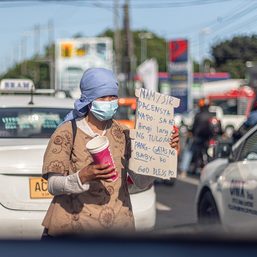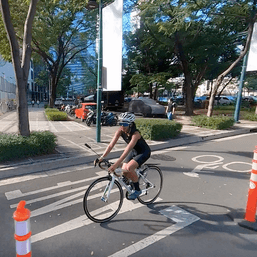SUMMARY
This is AI generated summarization, which may have errors. For context, always refer to the full article.
![[Rappler’s Best] Where the streets have no name](https://www.rappler.com/tachyon/2024/03/2-1.jpg)
Have you spent any of your weekends biking? You probably have – just to tune out or flex those frozen legs. But our 24-year-old environment reporter Iya Gozum is a hardcore biker. Thus it comes as no surprise that she’s turned her passion into one breathtaking story. She biked for 120 kilometers throughout Metro Manila to see how (un) friendly the nation’s capital is to bikers like her.
Watch her zigzag through the urban maze here.
As I biked with Iya virtually, her laps and turns and stops reminded me of a U2 song, “Where the Streets Have No Name.” Depending on how you’ve soaked in U2 history, the song is an ode to breaking free or to a world not segregated according to wealthy or filthy streets. The Philippines is one of the most class-conscious societies in the world, as eminent writer and teacher Butch Dalisay told us in this interview, and there’s no better proof of this than the streets where we live.
It doesn’t take much to realize it. If you live in an upper middle-class neighborhood, you’d have no trouble finding bike lanes for your daily exercise. A wealthy, well-managed city such as Iloilo City, named top bike-friendly city in 2021, can offer a bike tour – something that other cities are unable to. Iya herself concluded that Taguig, in particular, the elite BGC enclave, scored high in the bike-friendly department in the metro.
Why are there no sufficient spaces for bikes and more accessible means of transport? Again, class. As Iya’s investigation showed, our roads are built and maintained for private, not mass, transport, to the extent that they have become extended parking areas for cars. The biggest obstacle to a safe bike journey is the number of parked vehicles along Metro Manila’s major streets, according to Iya’s report. It’s after all an undeniable fact that most cities and towns have a bias for cars and private vehicles.

But it’s never too late to reimagine our cities.
The COVID-19 lockdown gave rise to pop-up bike lanes, and our daily traffic nightmare that’s costing us sanity and money is pushing us to look collectively for solutions.
- Over a third of Philippine households now use bikes, according to a Social Weather Stations survey in March 2023.
- A new generation of young adults is cycling toward sustainable communities. Read about it here.
- But as this story points out, can the Metro Manila cycling boom survive a revenge in car buying?
- With a tighter budget for bike lanes and pedestrians this year, the transportation department is nonetheless pushing through with the construction of the EDSA Greenways Project. It’s funded by a $123-million loan from the Asian Development Bank.
- How can you start pocket parks and people’s streets in your communities? Rappler’s community lead Pia Ranada-Robles tells us about it in this story.
Beyond the need for more lanes for active transport is the gaping hole in the country’s mass transport system. A few, even if delayed, fixes are being done, however.
Rappler’s Lance Spencer Yu gives us a tour of the initial construction phase of the Metro Manila Subway. Watch his report from 38 meters below the ground at the subway’s North Avenue Station in Quezon City. How will the 33-kilometer subway work once done? Here’s a guide to its 17 stations.
Unfortunately, there’s a price to pay for modernization: the Philippine National Railways will cease operations for at least five years, starting on March 28, to give way to the construction of the North-South Commuter Railway.
Will our roads – and therefore lives – get better in the coming years? We, at Rappler, don’t only hope for that, we’d like to do our part in making our cities liveable by starting with a campaign to #MakeManilaLiveable. We have created a dedicated space for stories and reports about the liveability of Philippine cities. Check out this page. For meaningful conversations on what we can all do together, join our chat room on liveable cities – but you first need to download the Rappler app (on iOS; on Android).
Let’s do this – one city at a time. – Rappler.com
Rappler’s Best is a weekly newsletter of our top picks delivered straight to your inbox every Monday.
To subscribe, visit rappler.com/profile and click the Newsletters tab. You need a Rappler account and you must log in to manage your newsletter subscriptions.
Add a comment
How does this make you feel?

















![[OPINION] Steps the Philippines can immediately take to reduce road casualties](https://www.rappler.com/tachyon/2024/05/Steps-the-Philippines-can-immediately-take-to-reduce-road-casualties.jpg?resize=257%2C257&crop_strategy=attention)


![[DOCUMENTARY] Biking 120 kilometers in Metro Manila](https://www.rappler.com/tachyon/2024/03/bike-commute-metro-manila-documentary-carousel-scaled.jpg?resize=257%2C257&crop=216px%2C0px%2C1440px%2C1440px)
![[EDITORIAL] Kamaynilaan para sa tao, hindi para sa mga sasakyan](https://www.rappler.com/tachyon/2024/04/animated-traffic-april-2024-carousel.jpg?resize=257%2C257&crop=410px%2C0px%2C720px%2C720px)
There are no comments yet. Add your comment to start the conversation.